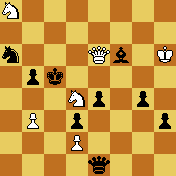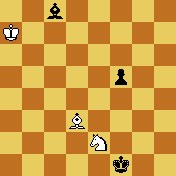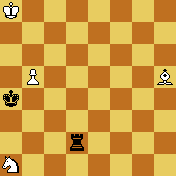Friday, April 29, 2005
Chess is Hard
So my two wins from this month's tournament turn out to be more complicated than I thought, and I haven't finished analysing them yet. Games _usually_ turn out to be more complicated than I first thought.

In the meantime, here's one more Henri Rinck composition from the little book I've been carrying around. White to play and win (from "O'pinio" 1934). Solution is a couple of paragraphs down.
What, are you kidding? Of course I didn't solve it. Chess is hard!
Solution: 1.Qb6+ Kb4 2.Qa5+! Kc5 (if 2...Kxa5 3.Nc6#) 3.Qc3+ Kd5 4.Qc6+ Ke5 (4...Kxd4 5.Qd6#) 5.Qe6+ Kf4 6.Qf6+ Kg3 7.Qh4+! Kxh4 8.Nf5#. Notice the really nifty echo of the mate in the note to Black's second move.
I'll try to get a game posted on the weekend.
Wednesday, April 20, 2005
The Quick&Dirty Guide to Using LT-PGN-Viewer
Nezha asked how the embedded boards work. I gave a short explanation in a comment to the last post. Here's the long explanation.
The game boards are on a website outside of blogspot, since you can't upload files to blogspot. I use the LT-Pgn_Viewer package. Get the pgnviewer.zip file from that link, upload it to your website, and unzip it into a directory of your choice.
Then you upload your pgn files to your website; give them a .txt extension rather than .pgn, because if your browser doesn't know what to do with a pgn file, it will download it instead of displaying.
Now you can display the games with the live board in your browser by using a url like: http://www.panix.com/~gaillard/chess/ltpgnviewer.html?games/ali.pgn.txt&ParsePgn=1 My website is "http://www.panix.com/~gaillard"; "chess" is the directory I unpacked the pgnviewer.zip in; "ltpgnviewer.html is from the LT-PGN-Viewer package; "games" is a subdirectory of "chess", and "ali.pgn.txt" is the pgn file to display. The "ParsePgn=1" tells the ltpgnviewer that it needs to parse the PGN into clickable JavaScript commands.
You should be able play though the game on most browsers (I've used Firefox and IE) if you have JavaScript enabled. However, some, like Opera, will not work.
To get it to work in Opera, you now do this: load that url in IE (or Firefox), right-click on the game area, view the source, and save it as an html file. Upload that html file to your website.
Now a URL like http://www.panix.com/~gaillard/chess/ltpgnviewer.html?games/ali.html should let you play over the game in any JavaScript-enabled browser. Notice that the "ParsePgn" argument is gone from the URL in this case; that's because when you saved the html file, you saved the already-parsed game.
Finally, to put that game board into your blogspot blog, you put an iframe in your post. The HTML
looks like this:
<iframe name="ali" scrolling="no" src="http://www.panix.com/~gaillard/chess/ltpgnviewer.html?games/ali.html" height="380" width="100%"></iframe>
You need to give the iframe a unique name if you have more than one in your blog, and you need to specify the height and width.
LT-PGN-Viewer has a lot of other options, like being able tyo have more than one game in a PGN file with,
with a list you can select individual game from. It comes with documentation.
Many thanks to Lutz Tautenhahn, author of LT-PGN-Viewer, both for providing this excellent free tool for chess websites, and for his great help in getting this to work on this blog.
Sunday, April 17, 2005
Round 1: Loss
Here's my first-round game from last weekend, a loss to IM Jay Bonin, I've played Jay...13 times, says my database, since 1978. Once in a while I nick him for a draw.
Normally, I'd clean up a game before posting it, but this time I wanted to give an idea of what my post-game analysis looks like, in case anyone cares. This is about 5 hours worth of work; I'll try to go back and do another couple of hours on it after I finish with the other games.
There's a couple of things to notice about this game. First, I had plenty of chances to get an equal or superior position, and missed them. Bonin just hung in there, kept playing decent moves, and waited for his chances to come--and they did. This is the same thing I did to Ali in my first post. In short, he outplayed me.
The other thing is that the main reasons for my loss were _not_ tactical. Yes, I missed a simple tactic (the decoy-and-fork at moves 30-31), and a tactic I probably wouldn't have spotted in Black's best line at move 29 means that I would have been struggling for the draw even without that one, but more important were psychological errors (I wanted to simplify the game, so I offered the exchange of Queens with 24...Qxe5, instead of the superior 24...Bxe5; exchanged on d4 before playing e5--thus freeing his QB--instead of playing ...e5 immediately; and avoided the complicated line starting with 18...Bxf2) and dogmatism (trying immediate action in the center with 6...Ne4 when I should have been developing instead, because acting in the center is "what you do" when the opponent starts a wing advance).
Analysing my two wins should take less time, and I expect to do them this week.
Friday, April 15, 2005
A study by Rinck
 White to play and win. (Henri Rinck, "Las Noticias" 1926).
White to play and win. (Henri Rinck, "Las Noticias" 1926).
I haven't had time yet to do the first pass at analyzing my games from last weekend. In the meantime, here's a simple but funny study from the little book of Rinck's compositions I'm currently carrying around.
Don't read the next paragraph if you want to try solving it yourself.
Solution: 1. Kb8 Bd7 (1...Ba6 hangs the Bishop; 1...Be6 loses it to 2. Nd4+) 2. Kc7 Be8 (Others lose the Bishop to a variety of discovered checks.) 3. Kd8 Bf7 (Again, other squares lose the Bishop to a Knight move discovering check.) 4. Ke7 (Inspector Javert continues his pursuit.) Bg8 5. Kf8 Bh7 6. Kg7 (Curtains. The King has outrun the Bishop on an open board.)
Monday, April 11, 2005
I have my doubts about opening preparation
I played a tournament at the Marshall Chess Club this weekend and did OK (lost to IM Jay Bonin, beat an Expert and a A-player). If my visualization training is doing anything, the games don't show it. The discouraging thing about my play is not how badly I play when I lose, it's how badly I play when I _win_. Anyway, I'll post the games this week sometime.
The point I want to bring up here is: I decided at the board to play the Dutch Defense against Bonin in round one, and played it again in the next round against an Expert. I got decent positions out of the opening both times, and went 1-1 with a performance rating around 2250. That's better than I usually do with Black with my normal opening (Pirc and King's Indian). Yeah, it's only two games, but still.
This was first time in about 20 years I played the Dutch. I used to play it a lot that, so the types of position that arose were familiar to me, but my entire "preparation" for playing it now was glancing at a few variations of some anti-Dutch lines (2.Nc3, 2.Bg5, and 2.e4) in Williams' _Play the Classical Dutch_ and the new Everyman _Starting Out_ book on the Dutch while standing in a bookstore last week. Total "preparation" time: less than a half hour.
Thursday, April 07, 2005
Study Plan
So, I've been back playing in tournaments for about a year and a half. My USCF rating has dropped a little less than 100 points, which is not too bad considering that (1) I'm older now, and sometimes I can hear the synapses clicking when I think and (2) there's been 50 to 100 points of rating deflation since the early '90s.
Still, I'd like to get _better_. My FIDE rating is in the 2150s, and I'm aiming for the FM title, the requirement for which is a 2300 rating. So, how to gain 150 points?
As I wrote about below, I did Khmelnitsky's _Chess Exam_ a couple of months ago. It told me a few surprising things, but mostly confirmed what I knew already.
_Chess Exam_ identified three areas where I'm strong: standard endgame positions (over 2450), which figures since I've been working my way through Dvoretsky's Endgame Manual for over a year; openings, which I've done a fair bit of systematic work on; and defense (both of those last two around 2250). "Defense" is a little surprising, since I've always considered myself a poor defensive player; I get nervous when my King is under pressure. But apparently I have the skills, it's just a problem of psychology.
In most areas, the exam pegged me between 2150 and 2200, which is pretty close to my actual strength. In three key areas, it puts me in the low 2000s. Those areas are tactics, identifying threats (which is really a species of tactics), and (weakest of all) calculation.
Well, that figures. It would have been nice if it had told me that I was a strong player except for, oh, strategic play or endgames or attack; the methods for improving those are pretty clear, and mostly involve study to increase my knowledge. But how to make aging brain visualize better? Not so clear.
I knew when I came back that tactics were going to be a weakness, so I did a ton of problems. I've been walking around for two years with Reinfeld's _1001 Winning Chess Combinations_ or Alburts _Chess Training Book_ in my pocket (..._and_ I'm happy to see you). It did help limit the damage. But what next?
One problem with doing a lot of fairly easy tactical exercises is that I stop looking for defenses (this is why 'recognizing threats' showed up as weak, I think). "Oh, a deflection and then a fork, very nice." I'd say, recognizing the pattern. That's fine for a problem but in a real game, it runs into "oops, he ignores the first move and plays a zwischenzug and I'm busted," or more frequently "so I get the fork and then he has a counter tactic," which I didn't see in time because I didn't visualize the end-position clearly enough.
So, as valuable as the repetitive-exercises method is, I need something different now. From the training guide in _Chess Exam_, and from a couple of other sources (like Tisdall's _Improve Your Chess Now_), I've come up with this:
1) Solving endgame studies. Studies are mostly tactics. In most there are both 'tries' that don't work and multiple defenses in the main line that have to be worked out. I'm now carrying around a little booklet of 100 studies by Henri Rinck that I picked up at Fred Wilson's chess book shop.
2) Blindfold practice. _Chess Exam_ says to play over short games or practice positions blindfold, and Tisdall suggests playing over miniatures blindfold, trying to fix intermediate positions in your mind and to visualize and 'solve' the game at the critical position.
3) Memorizing games, then playing them over and trying to analyze them blindfold. Ziyatdinov in _GM Ram_ recommends memorizing classic games, and gives a selection. It's rather fun, and replaying them blindfold is (like the studies and tactics books) something I can do on the subway to and from work.
I've also been playing correspondence chess (which takes a lot of time) and am continuing to work through Dvoretsky (and trying to find the solutions to the exercises without moving the pieces). In theory I should be thoroughly analyzing my tournament games, but this has fallen by the wayside because of time constraints. Analyzing my own games was a big part of how I made the push from Expert to Master in the first place. I will start doing it more again as my current correspondence tournament winds down.
Anyway, that's what I've been doing since mid-February. We'll see how it works out.
Saturday, April 02, 2005
A nice endgame study and a nifty diagram tool
A post on A Patzer's Quest pointed me to this nice tool for making PNG diagrams from FEN.
 Here's an example, an endgame study by B. Gusev and K. Sambatyan (found in EG #150, available from the EG archive site).
White to play and win.
Here's an example, an endgame study by B. Gusev and K. Sambatyan (found in EG #150, available from the EG archive site).
White to play and win.
I'll give the solution a couple of paragraphs down. That's a good-looking diagram, and the tool gives a number of style options. Hopefully all browsers understand PNG graphics by now? I may use this in the future instead of the tool I used for the diagram in the _Chess Exam_ review.
OK, Here's the solution:
1. b6 Ka3 (Otherwise the Knight escapes, and White can make Black give up his Rook for the b-pawn and mate with B+N) 2. b7 Rd8+ 3. Ka7 Kb2 (now the Knight is trapped, and the Rook controls the queening square. What ever can White do?) 4. Bg4! (Planning Bc8, interfering with the Rook's control of the 8th rank. If 4...Kxa1 5.Bc8 Rd3 6.b1Q Ra3+ 7.Ba6 and it's all over.) 4...Rd8 (Now if White blocks with Bc8, ...Re7 pins the pawn and draws.) 5.Bd7. The Rook has to move, but where? 5...Rd8, 6.Bc8 wins as seen before, so the Rook has to go somewhere else. Unfortunately for Black, 5...Rf8 6. Nb3 (run away!) 6...Kxb3 7.Bc8 Rf7 8.Be6+ wins the Rook, after which the Pawn queens; and the same fate awaits 5...Rh8 6.Nc2 Kxc2 7.Bc8 Rh7 8.Bg6+. (That's what composers call an "echo".) Nice!
This shared 1st and 2nd prize in the 1998 Moscow composing tournament, and _EG_ calls it the Study of the Year.